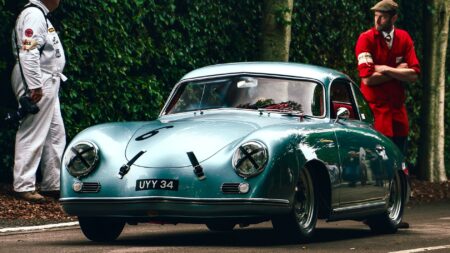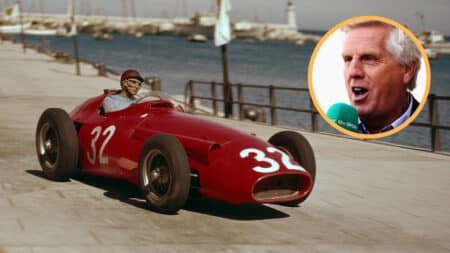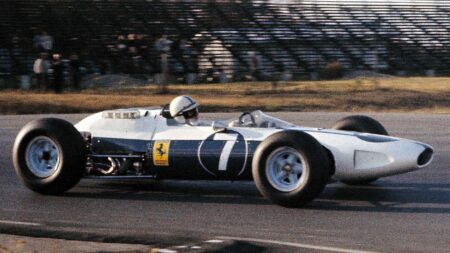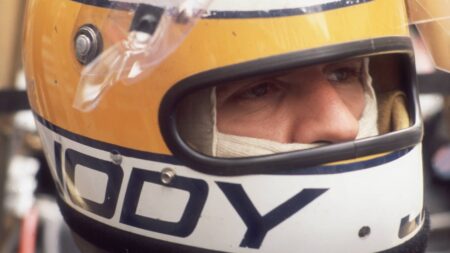
Denis Jenkinson's Porsche 356 roars again at Goodwood
Six decades after Motor Sport's famous continental correspondent Denis Jenkinson ran his Porsche 356 across Europe, it's now racing again following a long and careful restoration
Once upon a time, many years ago, there was a real Race of Champions, known as the International Race of Champions, or IROC, and I had the pleasure of covering the four-race series through its formative years, starting at Riverside in October of 1973.
The IROC was the brainchild of Roger Penske, who was able to sell Porsche on the idea of providing a brace of cars for four star drivers each from Formula 1, NASCAR, Indycars and long-distance sports cars. They’d run three races at Riverside in October in company with the Can-Am season-closer, followed by a finale at Daytona the following February.

Penske hired Jay Signore to run the IROC series, which he did in various configurations for more than 30 years through 2006. “Roger came up with the idea of the IROC series and he had a couple of partners in Mike Phelps, the TV guy, and Les Richter from Riverside,” Signore recalls. “The first year we ran the Porsches. We prepared and tested a couple of 911s. Mark Donohue and Al Holbert tested them and the team’s engineer Don Cox oversaw the engineering. After we finished testing we flew the cars back to Germany and the Porsche guys built a fleet of cars that came over by boat to California.
“We took the cars out to Riverside for the first IROC races at the end of 1973 and then they were shipped back to Reading. When they got to Reading we took them apart and sent the transaxles back to Germany for maintenance. Then we put the cars back together and went down to Daytona for the second and last round of the first IROC series, which Mark won.”
Donohue won three of the four races, including the finale on the road course at Daytona. I well remember the closing laps of that race as NASCAR star David Pearson began to catch Donohue as the leader’s brakes faded. Known as the ‘Silver Fox’, Pearson was a silky smooth driver who quickly mastered the art of driving a 911 as he finished the race on Donohue’s tail, not quite getting close enough to make a move.
“A little while later I was sitting in the shop and the news came that the Porsche deal had fallen through,” Signore says. “For a few months we were out of the IROC business. Then at Indy in May there was talk of starting the series again with Corvettes – Don Cox said we didn’t know much about Corvettes, but we did know a lot about Chevy Camaros from the Trans-Am days. So Roger shipped some Camaro street cars to Reading and we stripped them and made IROC cars out of them.”
The first four IROC races with the Camaros took place in the fall of 1974. USAC star Bobby Unser won the opener on the high-banked Michigan Speedway in September and Emerson Fittipaldi showed us why he was a world champion by winning the first of two races at Riverside the following month. And in the second race at Riverside, NASCAR ace Bobby Allison came through to win showing us that he could road race with the best of them.
At Daytona four months later Bobby Unser drove a masterful race to win on the high banks and take IROC’s second championship. AJ Foyt won the next two IROC titles with Al Unser winning in 1978 and defending F1 world champion Mario Andretti taking the title in ’79 and Bobby Allison prevailing the next year.
Through the next few years NASCAR drivers dominated the IROC series. In fact, other than Al Unser Jr winning a pair of IROC championships in 1986 and ’88, NASCAR drivers won every IROC championship through the series’ demise at the end of 2006.
“They started changing the venues more to ovals from road racing and going to bigger ovals like Daytona,” Signore recalls. “The Camaros were really not suited to superspeedways so we went to Banjo Mathews, who was the prominent stock car builder of the time, and asked him to build us some chassis.
“Banjo built all the chassis and we put the bodies on them at Penske Racing in Reading and we ran those cars for a long time. For four or five years we continued to run the IROC series out of Reading, but in 1981 we moved into a new shop in Red Bank, New Jersey, not far from where Roger lived.
“But the sport outgrew IROC. In the early days we had all the top drivers from Formula 1, Indycars, NASCAR and sports car racing. It was a lot of fun for quite a few years, but then each form of racing became more specialised and there was less and less room for any cross-over.
From the archive: Brundle’s busman’s holiday in IROC 1990
“Our approach was we invited drivers to come over to do special practice days. Our test drivers would work with them to teach them how to drive stock cars. But the price of eggs grew higher and higher and we just got priced out of the business. We closed the IROC operation in 2007.
“Fortunately we never hurt anybody in an IROC car,” Signore adds. “A few guys left feeling pretty sore, but there were no major injuries. We always tried to control the speeds but keep them so they could race and we wanted to make sure the cars were safe. That was the most important thing.”

I have many fine memories of IROC races from the early days, at Riverside in particular. It was a rare sight watching the likes of Foyt, Unser and Andretti doing battle with Fittipaldi, Ronnie Peterson, Jody Scheckter, Richard Petty, Bobby Allison, David Pearson and Cale Yarborough as they streamed through the high speed esses at Riverside and braked for the tight uphill Turn Six.
One year, on separate laps, both Peterson and Scheckter got it wrong, spinning through Turn Six and catching their monster stock cars on the exit. As I recall, Jody dropped a wheel into the dirt before carrying on while Ronnie kept all four wheels on the pavement, completing his loop perfectly and losing barely a second to the pack.
And 15 years later I witnessed a series of superb IROC duels at Daytona between Al Unser Jr and Dale Earnhardt. When Al Jr was at the height of his powers as a driver he used to amaze and frustrate Earnhardt and the other NASCAR drivers by running only a handful of practice laps at Daytona each year and then blowing them off in the race. Unser knew how to use the draft as well as the NASCAR stars, maybe even better, and one time Earnhardt taught him a lesson, using his fender in masterful fashion on the last lap to punt Unser out of the way and over the fence as he went on to win the race.
Back in those days it was a mark of pride for a driver to win an IROC championship, but changing times sucked the F1 drivers out of the series and as time went on the IROC became less and less international before running out of gas completely. Sadly, it’s unlikely anything like it will ever happen again.

Six decades after Motor Sport's famous continental correspondent Denis Jenkinson ran his Porsche 356 across Europe, it's now racing again following a long and careful restoration

Voice of 90’s motor racing is completing project to revive hidden gems of motor sport film and television.

Ferrari's F1 car is set to feature a 'blue livery' at the 2024 Miami GP – we look back on the other times Maranello cars haven't run in red

Think of the great Formula 1 champions and Jody Scheckter is unlikely to feature. But, writes Matt Bishop, the 1979 title-winner deserves more acclaim for a career in which he was once the best driver, bar none